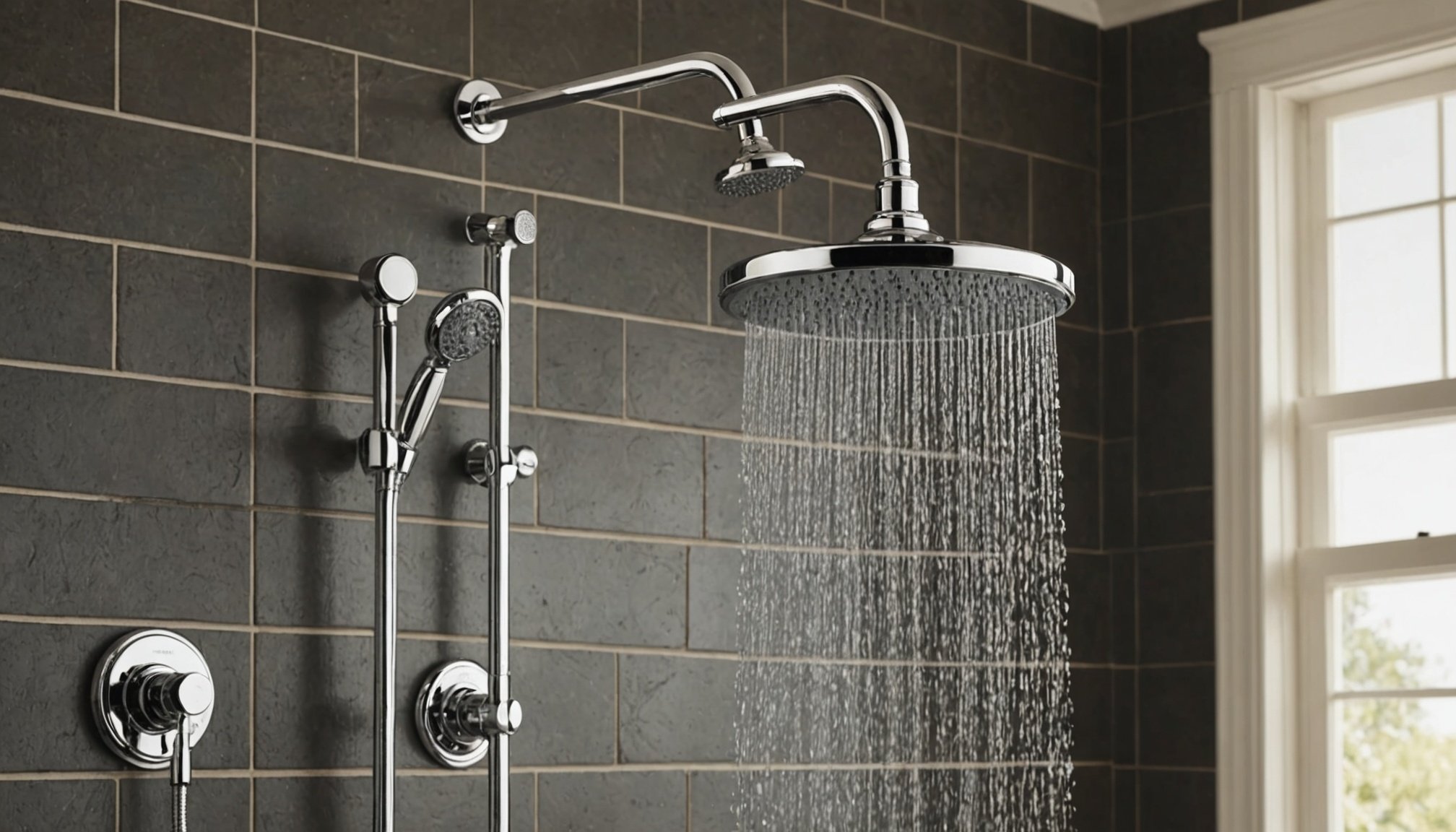Practical Methods for Retrofitting Vintage Homes with Low-Flow Showerheads
Retrofitting vintage homes with low-flow showerheads requires a careful, nuanced approach to maintain charm while ensuring sustainability. Identifying suitable locations for installation is crucial. Begin by examining existing plumbing systems to ensure they can accommodate modern sustainable upgrades without compromising integrity. Older systems may require adaptation to fit with current low-flow technology, making it important to plan meticulously.
Consider the aesthetics of your retrofit. Low-flow fixtures today are often designed with vintage aesthetics in mind, making it easier to maintain the home’s historical character. In this regard, selecting showerheads that match the vintage design of the interior helps to seamlessly integrate sustainable upgrades without sacrificing style. Functionality and aesthetics must meet to create a cohesive and visually appealing result.
This might interest you : Revitalize Your Home: Enhance Air Quality with Himalayan Salt Lamps and Living Air-Purifier Plants
A holistic vision is indispensable when embarking on such projects. Retrofitting involves balancing modern convenience with historical integrity. Sustainable upgrades to vintage homes not only contribute to the environmental impact by saving water and energy but also preserve the timeless allure these homes are known for. This balance of old-world charm and modern efficiency represents the future of sustainable living in heritage properties.
Step-by-Step Installation Guide
Retrofitting vintage homes with low-flow showerheads not only enhances sustainability but also requires precise installation.
In the same genre : Transform Your Guest Room: Design a Versatile Haven with a Home Gym!
Preparing for Installation
Begin by thoroughly assessing the existing plumbing and shower space to ensure compatibility with modern fixtures. Check for any damage or irregularities in the plumbing system of your vintage home. Gather the necessary tools such as a wrench, plumber’s tape, and the low-flow showerhead kit to streamline the process. When dealing with vintage plumbing, follow all safety considerations to avoid damaging valuable components or causing leaks. Turn off the water supply to the shower before proceeding further.
Installing the Low-Flow Showerhead
Remove the existing showerhead by unscrewing it carefully with a wrench, avoiding any stress on the plumbing connections. Next, fit the new low-flow fixture by wrapping plumber’s tape around the shower arm threads to ensure a tight seal. Screw the new showerhead on and make sure it is firmly attached. It’s paramount to check that the water pressure is adequate; enhancements may be needed to ensure full functionality of the new fixture without compromising its eco-friendly benefits.
Final Adjustments and Testing
After installation, inspect the setup for leaks, adjusting if necessary. Test the water flow and pressure, ensuring the shower delivers adequate performance. Make any minor aesthetic adjustments to ensure the cohesive integration of the showerhead with the surrounding vintage decor.
Maintaining Vintage Aesthetics
Retrofitting with low-flow fixtures offers a unique opportunity to preserve the classic appeal of vintage homes while introducing sustainability. Selecting showerheads that complement vintage designs is essential. Fortunately, many modern low-flow showerheads are crafted with aesthetics that resonate with traditional styles, enabling them to blend seamlessly with classic interiors.
One approach for successful design integration is to focus on materials and finishes that match existing bathroom features. For example, chrome or brass finishes can replicate the look of older fixtures, providing consistency throughout the space. Additionally, opt for designs with clean lines and subtle details that reflect the era of the home, ensuring that the character is maintained during renovations.
Another technique involves repainting or updating surrounding elements like tiles or fittings to support the integration of modern fixtures. This helps to create a harmonious balance between old and new. Moreover, retaining original elements, such as bathroom cabinets or mirrors, contributes to showcasing the home’s historical charm.
Ultimately, maintaining vintage aesthetics when installing low-flow showerheads is an artful balance of embracing modern eco-friendly enhancements without overshadowing the timeless beauty of classic homes.
Benefits of Low-Flow Showerheads
Retrofitting with low-flow showerheads offers significant advantages, particularly in terms of water conservation and energy savings. These modern fixtures reduce water use by approximately 40% compared to traditional models, significantly decreasing a household’s environmental footprint. The reduced water flow means less energy is necessary to heat water, leading to further economic benefits.
Beyond immediate savings, low-flow showerheads contribute to the long-term sustainability of natural resources. By lowering the overall demand for water, they play a crucial role in addressing environmental concerns such as water scarcity and energy overuse. Additionally, the installation of these eco-friendly upgrades often qualifies homeowners for rebates and incentives from government programs aimed at promoting sustainability, enhancing the financial appeal of these fixtures.
Moreover, over time, low-flow showerheads offer notable cost savings on water and energy bills, making them an attractive investment, particularly in vintage homes where charm meets practicality. By combining environmental benefits with financial incentives, these fixtures present a compelling case for homeowners eager to make sustainable choices without sacrificing style or comfort. Through well-planned retrofitting, these solutions champion both ecological responsibility and economic efficiency.
Product Recommendations
Retrofitting vintage homes with sustainable fixtures is a rewarding endeavor that blends eco-friendly products with classic aesthetics. When selecting showerhead recommendations, consider both functionality and style to complement your home’s character. Explore options with adjustable spray settings for maximum comfort and efficiency.
Top Low-Flow Showerheads on the Market
Focus on popular low-flow models that cater to vintage homes. For instance, the WaterSense labelled models often feature design elements that seamlessly blend with traditional interiors. These options balance water savings with aesthetic appeal. Compare features such as flow rates and spray patterns to choose both budget-friendly and premium selections, ensuring they align with vintage designs.
Eco-Friendly Materials and Technology
Opt for products made with sustainable materials such as recycled metals and BPA-free plastics. Modern innovations in low-flow technology, like air-infused spray nozzles, enhance water conservation while maintaining effective pressure. This technology not only supports the eco-friendly mission but ensures a premium showering experience.
User Testimonials and Case Studies
Investigate case studies highlighting successful installations in vintage homes. Homeowners’ feedback often reveals the balance achieved between functionality and preservation of vintage aesthetics. Learn from their experiences to address potential hurdles and optimize your retrofitting strategy.
Considerations for Plumbing Compatibility
Plumbing compatibility is a crucial factor when retrofitting vintage homes with low-flow showerheads for sustainable upgrades. Older plumbing systems often present unique challenges due to their age and materials. Therefore, a thorough assessment of the home’s plumbing infrastructure is essential to determine potential constraints and adaptations needed.
One key issue is the variation in pipe sizes commonly found in vintage homes. Old systems might have different dimensions compared to modern standards, necessitating specific connectors or adaptors to ensure a secure and functional fit for the low-flow fixtures. Additionally, the condition of the existing pipes should be evaluated to prevent leaks or bursts.
Adapting vintage plumbing systems involves delicate modifications. This may include replacing certain sections with more durable materials or employing pressure regulators to maintain water flow consistency while accommodating low-flow technology. For homeowners new to retrofitting, consulting with plumbing professionals can be invaluable. Their expertise ensures that the modifications honour the home’s historical integrity while achieving desired sustainability goals.
For complex retrofitting projects, expert advice provides peace of mind, helping to navigate technical nuances and ensure that the upgrade enhances both functionality and long-term durability of the plumbing system.

